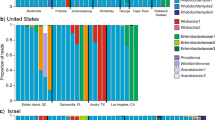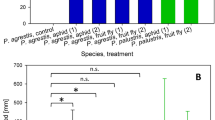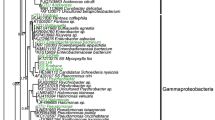Abstract
Maternally inherited bacterial endosymbionts are common in arthropods, but their distribution and prevalence are poorly characterized in many host taxa. Initial surveys have suggested that vertically transmitted symbionts may be particularly common in spiders (Araneae). Here, we used diagnostic PCR and high-throughput sequencing to evaluate symbiont infection in 267 individual spiders representing 14 species (3 families) of agricultural spiders. We found 27 operational taxonomic units (OTUs) that are likely endosymbiotic, including multiple strains of Wolbachia, Rickettsia, and Cardinium, which are all vertically transmitted and frequently associated with reproductive manipulation of arthropod hosts. Additional strains included Rickettsiella, Spiroplasma, Rhabdochlamydia, and a novel Rickettsiales, all of which could range from pathogenic to mutualistic in their effects upon their hosts. Seventy percent of spider species had individuals that tested positive for one or more endosymbiotic OTUs, and specimens frequently contained multiple symbiotic strain types. The most symbiont-rich species, Idionella rugosa, had eight endosymbiotic OTUs, with as many as five present in the same specimen. Individual specimens within infected spider species had a variety of symbiotypes, differing from one another in the presence or absence of symbiotic strains. Our sample included both starved and unstarved specimens, and dominant bacterial OTUs were consistent per host species, regardless of feeding status. We conclude that spiders contain a remarkably diverse symbiotic microbiota. Spiders would be an informative group for investigating endosymbiont population dynamics in time and space, and unstarved specimens collected for other purposes (e.g., food web studies) could be used, with caution, for such investigations.


Similar content being viewed by others
Data Availability
The nucleotide sequence data reported are available in the DDBJ/EMBL/GenBank database under accession numbers MK513512-19, MK521215-57, MK529759-77, MK627518-20, MK631910-40, MK632848-60, MN028387, and the NCBI SRA under PRJNA526944. The datasets analyzed herein are available from the authors upon request.
References
Weinert LA, Araujo-Jnr EV, Ahmed MZ, Welch JJ (2015) The incidence of bacterial endosymbionts in terrestrial arthropods. Proc R Soc B Biol Sci 282(1807):20150249. https://doi.org/10.1098/rspb.2015.0249
Sazama EJ, Ouellette SP, Wesner JS (2019) Bacterial endosymbionts are common among, but not necessarily within, insect species. Environ Entomol 48:127–133. https://doi.org/10.1093/ee/nvy188
LePage D, Bordenstein SR (2013) Wolbachia: can we save lives with a great pandemic? Trends Parasitol 29(8):385–393. https://doi.org/10.1016/j.pt.2013.06.003
Huigens ME, de Almeida RP, Boons PAH, Luck RF, Stouthamer R (2004) Natural interspecific and intraspecific horizontal transfer of parthenogenesis-inducing Wolbachia in Trichogramma wasps. Proc R Soc Lond B Biol 271(1538):509–515. https://doi.org/10.1098/rspb.2003.2640
Duron O, Wilkes TE, Hurst GDD (2010) Interspecific transmission of a male-killing bacterium on an ecological timescale. Ecol Lett 13(9):1139–1148. https://doi.org/10.1111/j.1461-0248.2010.01502.x
Stahlhut JK, Desjardins CA, Clark ME, Baldo L, Russell JA, Werren JH, Jaenike J (2010) The mushroom habitat as an ecological arena for global exchange of Wolbachia. Mol Ecol 19(9):1940–1952. https://doi.org/10.1111/j.1365-294X.2010.04572.x
Caspi-Fluger A, Inbar M, Mozes-Daube N, Katzir N, Portnoy V, Belausov E, Hunter MS, Zchori-Fein E (2012) Horizontal transmission of the insect symbiont Rickettsia is plant-mediated. Proc R Soc B-Biol Sci 279(1734):1791–1796. https://doi.org/10.1098/rspb.2011.2095
Gehrer L, Vorburger C (2012) Parasitoids as vectors of facultative bacterial endosymbionts in aphids. Biol Lett 8(4):613–615. https://doi.org/10.1098/rsbl.2012.0144
Jaenike J, Unckless R, Cockburn SN, Boelio LM, Perlman SJ (2010) Adaptation via symbiosis: recent spread of a Drosophila defensive symbiont. Science 329(5988):212–215. https://doi.org/10.1126/science.1188235
Himler AG, Adachi-Hagimori T, Bergen JE, Kozuch A, Kelly SE, Tabashnik BE, Chiel E, Duckworth VE, Dennehy TJ, Zchori-Fein E, Hunter MS (2011) Rapid spread of a bacterial symbiont in an invasive whitefly is driven by fitness benefits and female bias. Science 332(6026):254–256. https://doi.org/10.1126/science.1199410
Werren JH, Baldo L, Clark ME (2008) Wolbachia: master manipulators of invertebrate biology. Nat Rev Microbiol 6(10):741–751. https://doi.org/10.1038/nrmicro1969
Arai H, Hirano T, Akizuki N, Abe A, Nakai M, Kunimi Y, Inoue MN (2019) Multiple infection and reproductive manipulations of Wolbachia in Homona magnanima (Lepidoptera: Tortricidae). Microb Ecol 77(1):257–266. https://doi.org/10.1007/s00248-018-1210-4
Vanthournout B, Hendrickx F (2015) Endosymbiont dominated bacterial communities in a dwarf spider. PLoS One 10(2):e0117297. https://doi.org/10.1371/journal.pone.0117297
Russell JA, Weldon S, Smith AH, Kim KL, Hu Y, Łukasik P, Doll S, Anastopoulos I, Novin M, Oliver KM (2013) Uncovering symbiont-driven genetic diversity across North American pea aphids. Mol Ecol 22:2045–2059. https://doi.org/10.1111/mec.12211
Engelstadter J, Telschow A, Hammerstein P (2004) Infection dynamics of different Wolbachia-types within one host population. J Theor Biol 231(3):345–355. https://doi.org/10.1016/j.jtbi.2004.06.029
Engelstadter J, Telschow A (2009) Cytoplasmic incompatibility and host population structure. Heredity 103(3):196–207. https://doi.org/10.1038/hdy.2009.53
Turelli M, Hoffmann AA (1991) Rapid spread of an inherited incompatibility factor in California Drosophila. Nature 353(6343):440–442. https://doi.org/10.1038/353440a0
Chiel E, Gottlieb Y, Zchori-Fein E, Mozes-Daube N, Katzir N, Inbar M, Ghanim M (2007) Biotype-dependent secondary symbiont communities in sympatric populations of Bemisia tabaci. Bull Entomol Res 97(4):407–413. https://doi.org/10.1017/S0007485307005159
Ferrari J, West JA, Via S, Godfray HCJ (2012) Population genetic structure and secondary symbionts in host-associated populations of the pea aphid complex. Evolution 66(2):375–390. https://doi.org/10.1111/j.1558-5646.2011.01436.x
Goodacre SL, Martin OY, Thomas CFG, Hewitt GM (2006) Wolbachia and other endosymbiont infections in spiders. Mol Ecol 15(2):517–527. https://doi.org/10.1111/j.1365-294X.2005.02802.x
Baldo L, Ayoub NA, Hayashi CY, Russell JA, Stahlhut JK, Werren JH (2008) Insight into the routes of Wolbachia invasion: high levels of horizontal transfer in the spider genus Agelenopsis revealed by Wolbachia strain and mitochondrial DNA diversity. Mol Ecol 17:557–569. https://doi.org/10.1111/j.1365-294X.2007.03608.x
Duron O, Hurst GDD, Hornett EA, Josling JA, Engelstadter J (2008) High incidence of the maternally inherited bacterium Cardinium in spiders. Mol Ecol 17(6):1427–1437. https://doi.org/10.1111/j.1365-294X.2008.03689.x
Perlman SJ, Magnus SA, Copley CR (2010) Pervasive associations between Cybaeus spiders and the bacterial symbiont Cardinium. J Invertebr Pathol 103(3):150–155. https://doi.org/10.1016/j.jip.2009.12.009
Yun YL, Lei CL, Peng Y, Liu FX, Chen JA, Chen LB (2011) Wolbachia strains typing in different geographic population spider, Hylyphantes graminicola (Linyphiidae). Curr Microbiol 62(1):139–145. https://doi.org/10.1007/s00284-010-9686-2
Vanthournout B, Vandomme V, Hendrickx F (2014) Sex ratio bias caused by endosymbiont infection in the dwarf spider Oedothorax retusus. J Arachnol 42(1):24–33
Curry M, Paliulis LV, Welch K, Harwood J, White J (2015) Multiple endosymbiont infections and reproductive manipulations in a linyphiid spider population. Heredity 115(2):146–152. https://doi.org/10.1038/hdy.2015.2
Zhang L, Yun Y, Hu G, Peng Y (2018) Insights into the bacterial symbiont diversity in spiders. Ecol Evol 8(10):4899–4906. https://doi.org/10.1002/ece3.4051
Wang GH, Jia LY, Xiao JH, Huang DW (2016) Discovery of a new Wolbachia supergroup in cave spider species and the lateral transfer of phage WO among distant hosts. Infect Genet Evol 41:1–7. https://doi.org/10.1016/j.meegid.2016.03.015
Barrett RD, Hebert PD (2005) Identifying spiders through DNA barcodes. Can J Zool 83(3):481–491. https://doi.org/10.1139/z05-024
Chapman EG, Schmidt JM, Welch KD, Harwood JD (2013) Molecular evidence for dietary selectivity and pest suppression potential in an epigeal spider community in winter wheat. Biol Control 65(1):72–86. https://doi.org/10.1016/j.biocontrol.2012.08.005
Baldo L, Hotopp J, Jolley K, Bordenstein SR, Biber S, Choudhury R, Hayashi CY, Maiden M, Tettelin H, Werren J (2006) Multilocus sequence typing system for the endosymbiont Wolbachia pipientis. Appl Environ Microbiol 72:7098–7110. https://doi.org/10.1128/AEM.00731-06
Kozich JJ, Westcott SL, Baxter NT, Highlander SK, Schloss PD (2013) Development of a dual-index sequencing strategy and curation pipeline for analyzing amplicon sequence data on the MiSeq Illumina sequencing platform. Appl Environ Microbiol 79(17):5112–5120. https://doi.org/10.1128/AEM.01043-13
Caporaso JG, Kuczynski J, Stombaugh J, Bittinger K, Bushman FD, Costello EK, Fierer N, Pena AG, Goodrich JK, Gordon JI et al (2010) QIIME allows analysis of high-throughput community sequencing data. Nat Methods 7(5):335–336. https://doi.org/10.1038/nmeth.f.303
Bokulich NA, Subramanian S, Faith JJ, Gevers D, Gordon JI, Knight R, Mills DA, Caporaso JG (2012) Quality-filtering vastly improves diversity estimates from Illumina amplicon sequencing. Nat Methods 10:57–59. https://doi.org/10.1038/nmeth.2276
Amir A, McDonald D, Navas-Molina JA, Kopylova E, Morton JT, Xu ZZ, Kightley EP, Thompson LR, Hyde ER, Gonzalez A (2017) Deblur rapidly resolves single-nucleotide community sequence patterns. MSystems 2(2):e00191–e00116. https://doi.org/10.1128/mSystems.00191-16
DeSantis TZ, Hugenholtz P, Larsen N, Rojas M, Brodie EL, Keller K, Huber T, Dalevi D, Hu P, Andersen GL (2006) Greengenes, a chimera-checked 16S rRNA gene database and workbench compatible with ARB. Appl Environ Microbiol 72(7):5069–5072. https://doi.org/10.1128/AEM.03006-05
Katoh K, Rozewicki J, Yamada KD (2017) MAFFT online service: multiple sequence alignment, interactive sequence choice and visualization. Brief Bioinf bbx108. https://doi.org/10.1093/bib/bbx108
Zwickl DJ (2006) Genetic algorithm approaches for the phylogenetic analysis of large biological sequence datasets under the maximum likelihood criterion. PhD Thesis, The University of Texas at Austin. https://code.google.com/archive/p/garli/. Accessed 10 Feb 2014
Rodriguez F, Oliver JL, Marin A, Medina JR (1990) The general stochastic model of nucleotide substitution. J Theor Biol 142:485–501. https://doi.org/10.1016/S0022-5193(05)80104-3
Huelsenbeck JP, Rannala B (2004) Frequentist properties of Bayesian posterior probabilities of phylogenetic trees under simple and complex substitution models. Syst Biol 53:904–913. https://doi.org/10.1080/10635150490522629
Felsenstein J (1985) Confidence limits on phylogenies: an approach using the bootstrap. Evolution 39:783–791. https://doi.org/10.2307/2408678
Larsson AJ, Stanley G, Sinha R, Weissman IL, Sandberg R (2018) Computational correction of index switching in multiplexed sequencing libraries. Nat Methods 15(5):305–307. https://doi.org/10.1038/nmeth.4666
Lozupone C, Knight R (2005) UniFrac: a new phylogenetic method for comparing microbial communities. Appl Environ Microbiol 71(12):8228–8235. https://doi.org/10.1128/AEM.71.12.8228-8235.2005
Curry MM (2013) Endosymbiotic prevalence and reproductive manipulation of the spider Mermessus fradeorum. MS Thesis, University of Kentucky, Lexington, KY
Duron O, Bouchon D, Boutin S, Bellamy L, Zhou L, Engelstadter J, Hurst GDD (2008) The diversity of reproductive parasites among arthropods: Wolbachia do not walk alone. BMC Biol 6:27. https://doi.org/10.1186/1741-7007-6-27
Takano S-i, Tuda M, Takasu K, Furuya N, Imamura Y, Kim S, Tashiro K, Iiyama K, Tavares M, Amaral AC (2017) Unique clade of alphaproteobacterial endosymbionts induces complete cytoplasmic incompatibility in the coconut beetle. Proc Natl Acad Sci U S A 114(23):6110–6115. https://doi.org/10.1073/pnas.1618094114
Leclerque A, Kleespies RG (2008) Type IV secretion system components as phylogenetic markers of entomopathogenic bacteria of the genus Rickettsiella. FEMS Microbiol Lett 279(2):167–173. https://doi.org/10.1111/j.1574-6968.2007.01025.x
Tsuchida T, Koga R, Horikawa M, Tsunoda T, Maoka T, Matsumoto S, Simon JC, Fukatsu T (2010) Symbiotic bacterium modifies aphid body color. Science 330(6007):1102–1104. https://doi.org/10.1126/science.1195463
Duron O, Cremaschi J, McCoy KD (2016) The high diversity and global distribution of the intracellular bacterium Rickettsiella in the polar seabird tick Ixodes uriae. Microb Ecol 71(3):761–770. https://doi.org/10.1007/s00248-015-0702-8
Corsaro D, Thomas V, Goy G, Venditti D, Radek R, Greub G (2007) ‘Candidatus Rhabdochlamydia crassificans’, an intracellular bacterial pathogen of the cockroach Blatta orientalis (Insecta: Blattodea). Syst Appl Microbiol 30(3):221–228. https://doi.org/10.1016/j.syapm.2006.06.001
Vanthournout B, Swaegers J, Hendrickx F (2011) Spiders do not escape reproductive manipulations by Wolbachia. BMC Evol Biol 11:15. https://doi.org/10.1186/1471-2148-11-15
Stefanini A, Duron O (2012) Exploring the effect of the Cardinium endosymbiont on spiders. J Evol Biol 25(8):1521–1530. https://doi.org/10.1111/j.1420-9101.2012.02535.x
Feldhaar H (2011) Bacterial symbionts as mediators of ecologically important traits of insect hosts. Ecol Entomol 36(5):533–543. https://doi.org/10.1111/j.1365-2311.2011.01318.x
Goodacre SL, Martin OY, Bonte D, Hutchings L, Woolley C, Ibrahim K, Thomas CFG, Hewitt GM (2009) Microbial modification of host long-distance dispersal capacity. BMC Biol 7:32. https://doi.org/10.1186/1741-7007-7-32
Gunnarsson B, Goodacre SL, Hewitt GM (2009) Sex ratio, mating behaviour and Wolbachia infections in a sheetweb spider. Biol J Linn Soc 98(1):181–186. https://doi.org/10.1111/j.1095-8312.2009.01247.x
Denno RF, Mitter MS, Langellotto GA, Gratton C, Finke DL (2004) Interactions between a hunting spider and a web-builder: consequences of intraguild predation and cannibalism for prey suppression. Ecol Entomol 29(5):566–577. https://doi.org/10.1111/j.0307-6946.2004.00628.x
Wise DH (2006) Cannibalism, food limitation, intraspecific competition, and the regulation of spider populations. Annu Rev Entomol 51:441–465. https://doi.org/10.1146/annurev.ento.51.110104.150947
Yun Y, Peng Y, Liu FX, Lei C (2011) Wolbachia screening in spiders and assessment of horizontal transmission between predator and prey. Neotrop Entomol 40(2):164–169. https://doi.org/10.1590/S1519-566X2011000200002
Sun D-L, Jiang X, Wu QL, Zhou N-Y (2013) Intragenomic heterogeneity of 16S rRNA genes causes overestimation of prokaryotic diversity. Appl Environ Microbiol 79(19):5962–5969. https://doi.org/10.1128/aem.01282-13
Větrovský T, Baldrian P (2013) The variability of the 16S rRNA gene in bacterial genomes and its consequences for bacterial community analyses. PLoS One 8(2):e57923. https://doi.org/10.1371/journal.pone.0057923
Acknowledgments
We thank J. Harwood and J. Dryer for providing and collecting specimens, and three anonymous reviewers for comments on an earlier draft of this manuscript.
Funding
This research work was supported by grants from the Kentucky Science and Engineering Foundation as per Grant/Award Agreements 148-502-10-261 and 148-502-16-377 with the Kentucky Science and Technology Corporation, and the National Institute of Food and Agriculture, U.S. Department of Agriculture (Hatch No. 0224651).
Author information
Authors and Affiliations
Corresponding author
Electronic Supplementary Material
Online Resource 1
Individual spider specimens, diagnostic results, and sequences. Tab1 includes metadata, diagnostic results, COI haplotypes and bacterial strain types associated with each specimen. Tab 2 provides the Genbank accession number and sequences associated with each COI haplotype and bacterial strain type. (XLSX 62 kb)
Online Resource 2
Diagnostic PCR primers. (PDF 120 kb)
Online Resource 3
High throughput read distribution per sample. (XLSX 36 kb)
Online Resource 4
Figs. S1 & S2 Microbiome profile of starved versus unstarved specimens of (Fig. S1) Idionella rugosa and (Fig. S2) Glenognatha foxi. Each profile was generated from a rarified sample of 3000 Illumina MiSeq reads of the V4 region of bacterial 16S rRNA. The 7-8 most common genera are presented in the key for each figure; in Fig. S1, Cardinium, Wolbachia and Rickettsia each encompass two distinct strain type OTUs. In Fig. S2, many of these OTUs could only be placed at the family or order level. (PDF 260 kb)
Rights and permissions
About this article
Cite this article
White, J.A., Styer, A., Rosenwald, L.C. et al. Endosymbiotic Bacteria Are Prevalent and Diverse in Agricultural Spiders. Microb Ecol 79, 472–481 (2020). https://doi.org/10.1007/s00248-019-01411-w
Received:
Accepted:
Published:
Issue Date:
DOI: https://doi.org/10.1007/s00248-019-01411-w




